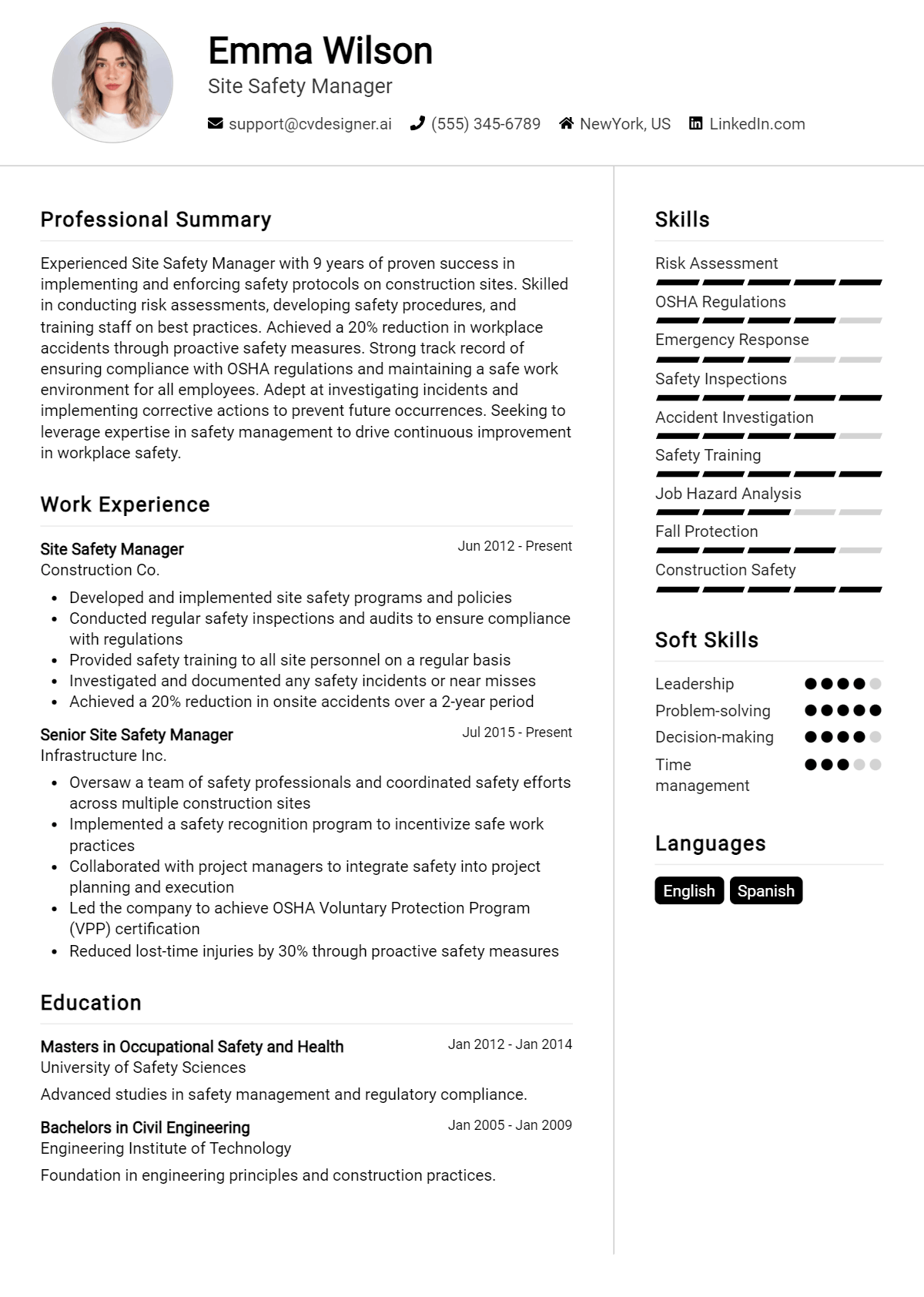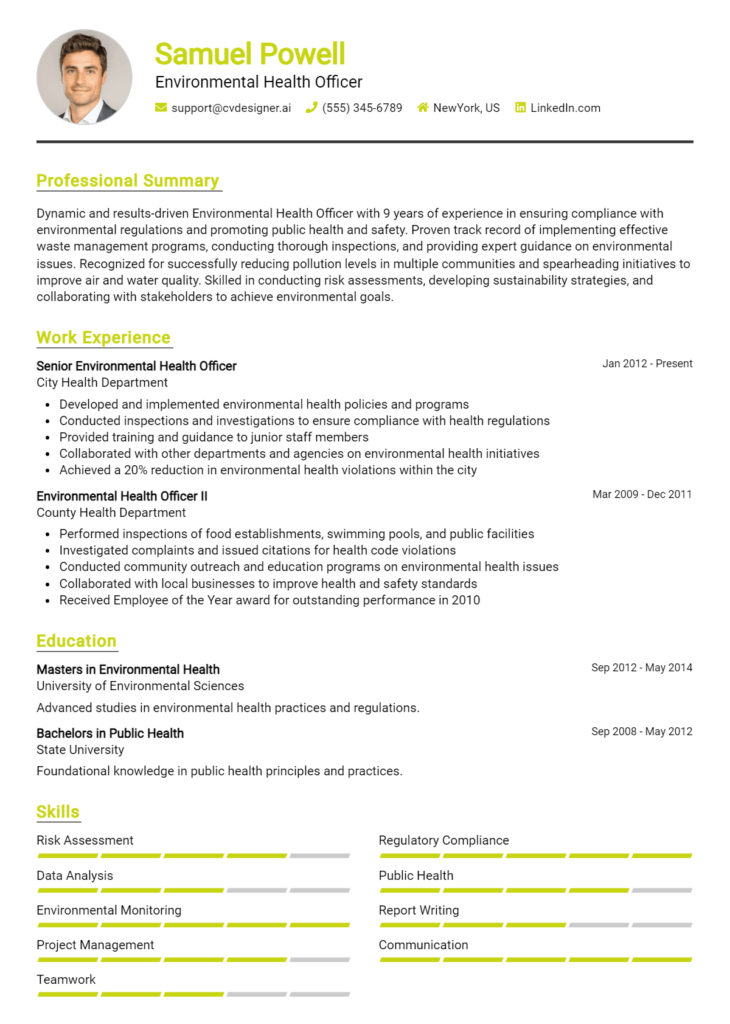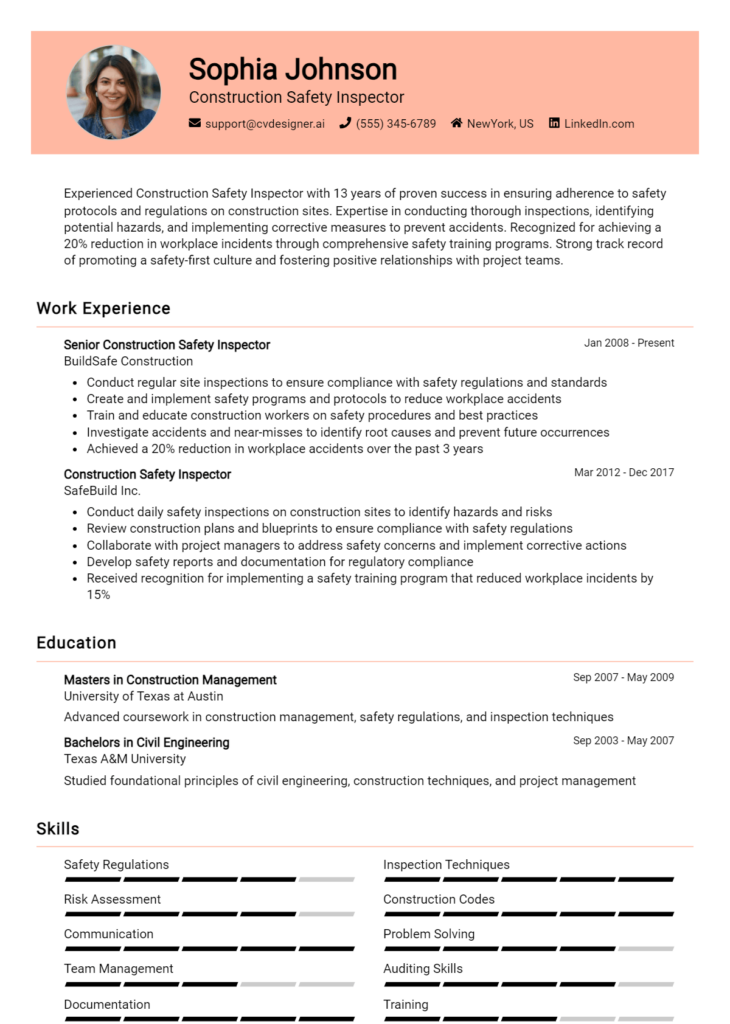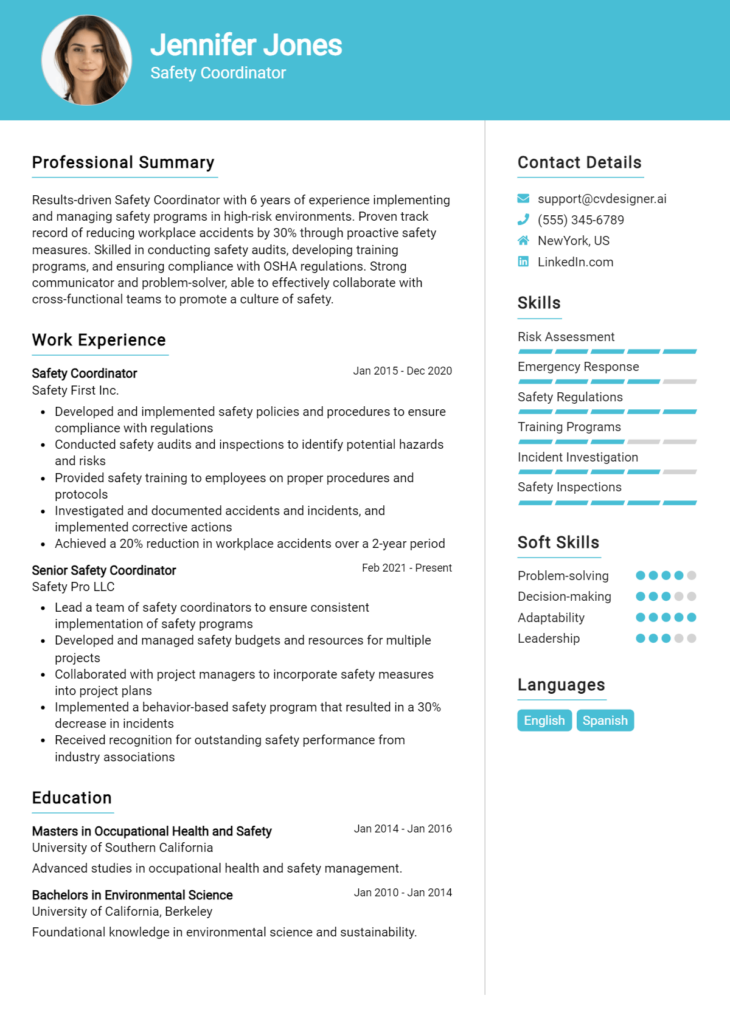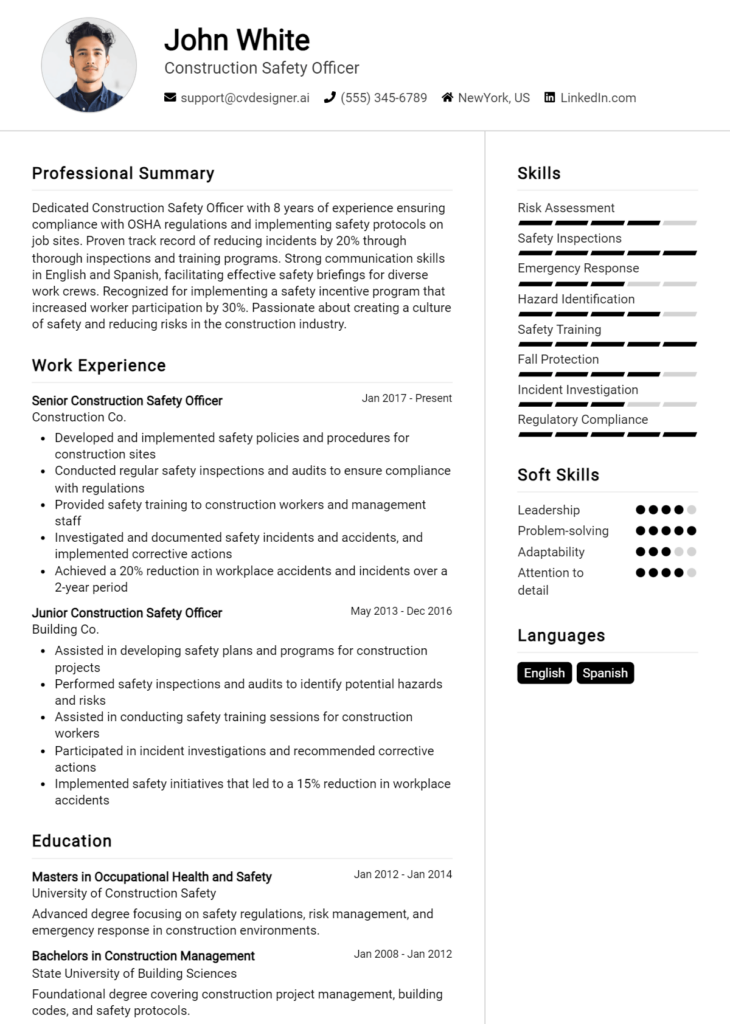Site Safety Manager Core Responsibilities
A Site Safety Manager plays a crucial role in ensuring a safe working environment by bridging various departments such as operations, human resources, and compliance. Key responsibilities include conducting risk assessments, developing safety protocols, and providing training to staff. Essential skills encompass technical knowledge of safety regulations, operational awareness, and strong problem-solving capabilities. These competencies are vital for achieving organizational safety goals. A well-structured resume can effectively highlight these qualifications, making candidates stand out in the job market.
Common Responsibilities Listed on Site Safety Manager Resume
- Conduct regular site inspections and audits to identify safety hazards.
- Develop and implement safety training programs for employees.
- Monitor compliance with health and safety regulations.
- Investigate accidents and incidents to determine root causes.
- Create and maintain safety documentation and reports.
- Collaborate with various departments to promote a culture of safety.
- Lead safety meetings and provide ongoing safety communication.
- Stay updated on industry trends and regulatory changes.
- Implement emergency response plans and conduct drills.
- Advise management on safety-related issues and improvements.
- Manage safety equipment and ensure proper maintenance.
High-Level Resume Tips for Site Safety Manager Professionals
In the competitive field of site safety management, a well-crafted resume serves as your personal marketing tool, often making the crucial first impression on potential employers. Your resume is not just a list of past jobs; it should reflect your unique skills, achievements, and commitment to creating safe work environments. As a Site Safety Manager, your ability to effectively communicate your qualifications can set you apart from other candidates, highlighting your expertise in risk management, compliance, and safety training. This guide will provide practical and actionable resume tips specifically tailored for Site Safety Manager professionals, ensuring that you present yourself in the best possible light to prospective employers.
Top Resume Tips for Site Safety Manager Professionals
- Tailor your resume to each job description by incorporating keywords and phrases that match the specific requirements of the position.
- Highlight your relevant experience by focusing on roles that directly relate to site safety, risk management, and compliance.
- Quantify your achievements with specific metrics, such as reducing incidents by a certain percentage or successfully implementing safety programs that improved compliance rates.
- Showcase industry-specific certifications, such as OSHA, NEBOSH, or other relevant training, to demonstrate your qualifications and commitment to safety standards.
- Include a summary statement that clearly outlines your expertise, years of experience, and key competencies in site safety management.
- Utilize bullet points for clarity and ease of reading, ensuring that each point succinctly conveys a specific skill or achievement.
- Demonstrate your ability to lead safety training sessions and initiatives, providing examples of how you have successfully educated teams on safety protocols.
- Incorporate soft skills such as communication, leadership, and problem-solving, which are essential for effectively managing safety on-site.
- Keep the format clean and professional, using consistent fonts and spacing to enhance readability and overall presentation.
By implementing these resume tips, you can significantly enhance your chances of landing a job in the Site Safety Manager field. A well-structured and targeted resume will not only showcase your qualifications but also demonstrate your commitment to promoting safety and compliance in the workplace. Taking the time to refine your resume can lead to more interview opportunities and ultimately help you secure the position you desire.
Why Resume Headlines & Titles are Important for Site Safety Manager
In the competitive field of site safety management, a well-crafted resume headline or title serves as a critical first impression for job seekers. This brief yet powerful phrase can immediately capture the attention of hiring managers and succinctly summarize a candidate's key qualifications. A strong resume headline should be concise, relevant, and directly aligned with the job being applied for, effectively positioning the candidate as a suitable choice for the role. By highlighting essential skills, certifications, or years of experience, the headline sets the tone for the entire resume and encourages employers to delve deeper into the candidate's qualifications.
Best Practices for Crafting Resume Headlines for Site Safety Manager
- Keep it concise: Aim for a headline that is no longer than 10 words.
- Be role-specific: Use keywords related to site safety management to enhance relevance.
- Highlight key qualifications: Focus on your most impressive credentials or achievements.
- Use action-oriented language: Opt for dynamic verbs that convey your proactive approach.
- Tailor for each application: Customize your headline to match the specific job description.
- Avoid jargon: Keep the language clear and accessible for a wider audience.
- Include certifications: If applicable, mention relevant safety certifications to enhance credibility.
- Showcase leadership: Emphasize your experience in leading safety initiatives or teams.
Example Resume Headlines for Site Safety Manager
Strong Resume Headlines
Dedicated Site Safety Manager with 10+ Years in Construction Safety.
Certified Safety Professional Committed to Reducing Workplace Hazards.
Results-Driven Site Safety Manager with Proven Track Record of Compliance.
Experienced Safety Leader Focused on Enhancing Team Performance and Safety Culture.
Weak Resume Headlines
Looking for a Job in Safety.
Safety Manager with Experience.
Professional Seeking Opportunities in the Safety Field.
The strong headlines are effective because they clearly communicate the candidate’s experience, skills, and value proposition in a few impactful words. They give hiring managers a quick glimpse into what the candidate brings to the table, making them more likely to explore the resume further. In contrast, the weak headlines lack specificity and fail to convey any unique qualifications, making it difficult for hiring managers to understand the candidate's potential contributions or differentiate them from others. A compelling headline is essential for standing out in a crowded job market.
Writing an Exceptional Site Safety Manager Resume Summary
A resume summary is a critical component for a Site Safety Manager, as it serves as the first impression a hiring manager will have of the candidate. A well-crafted summary succinctly highlights key skills, relevant experience, and notable accomplishments that align with the job role. In a competitive job market, a strong summary can quickly capture the attention of hiring managers, compelling them to delve deeper into the candidate's qualifications. It should be concise, impactful, and tailored specifically to the job description, ensuring that it resonates with the needs of the employer.
Best Practices for Writing a Site Safety Manager Resume Summary
- Quantify Achievements: Use numbers and statistics to demonstrate your impact on safety performance and risk reduction.
- Focus on Relevant Skills: Highlight key skills such as risk assessment, safety training, and regulatory compliance that are pertinent to the role.
- Tailor for the Job Description: Customize your summary to reflect the specific requirements and responsibilities mentioned in the job posting.
- Use Action-Oriented Language: Start sentences with strong action verbs to convey your proactive approach to safety management.
- Keep it Concise: Aim for 3-5 sentences that clearly communicate your professional identity and qualifications.
- Include Industry-Specific Terminology: Use relevant jargon that shows your familiarity with safety practices and regulations in the construction or industrial sector.
- Showcase Leadership Qualities: Emphasize your ability to lead safety teams and initiatives effectively.
- Reflect Professional Growth: Mention any certifications, training, or advancements that demonstrate your commitment to professional development in safety management.
Example Site Safety Manager Resume Summaries
Strong Resume Summaries
Dynamic Site Safety Manager with over 10 years of experience in implementing comprehensive safety programs that reduced workplace incidents by 30%. Proven ability to lead safety training for large teams and ensure compliance with OSHA regulations.
Results-driven safety professional with a track record of developing and executing safety protocols that achieved a 25% reduction in accidents over two years. Expertise in risk assessment, hazard analysis, and incident investigation.
Certified Safety Professional with 8+ years of experience in the construction industry. Successfully managed safety audits that led to a 40% decrease in violations and enhanced employee safety training programs.
Weak Resume Summaries
Experienced safety manager looking for a new opportunity to use my skills.
Dedicated professional with safety knowledge and a desire to maintain safe working environments.
The examples of strong resume summaries are considered effective because they provide specific, quantifiable achievements and demonstrate relevant skills tailored to the Site Safety Manager role. They use action-oriented language and highlight the candidate's impact on safety performance. In contrast, the weak resume summaries lack detail and measurable outcomes, making them too vague and generic to stand out in a competitive job market.
Work Experience Section for Site Safety Manager Resume
The work experience section of a Site Safety Manager resume is crucial as it provides potential employers with a clear view of the candidate's hands-on experience, technical skills, and ability to lead safety initiatives effectively. This section not only highlights the candidate's capability to manage teams and ensure compliance with safety regulations but also demonstrates their track record of delivering high-quality outcomes. By quantifying achievements and aligning their experiences with industry standards, candidates can significantly enhance their appeal to hiring managers looking for proven safety leaders.
Best Practices for Site Safety Manager Work Experience
- Clearly outline specific safety protocols and regulations adhered to in previous roles.
- Quantify achievements, such as reduction in incidents or compliance gaps.
- Highlight leadership roles, showcasing team management and training efforts.
- Include examples of successful collaboration with other departments and stakeholders.
- Use action verbs to describe responsibilities and achievements vividly.
- Align experiences with industry standards and certifications relevant to safety management.
- Demonstrate proactive measures taken to improve safety culture and practices.
- Showcase experience with safety audits and incident investigations.
Example Work Experiences for Site Safety Manager
Strong Experiences
- Led a team of 15 safety professionals, resulting in a 30% reduction in workplace incidents over two years.
- Implemented a new safety training program that improved employee compliance rates by 40% within six months.
- Coordinated safety audits across multiple sites, achieving 100% compliance with OSHA regulations.
- Developed and enforced a safety reporting system that increased incident reporting accuracy by 50%.
Weak Experiences
- Assisted with safety meetings and discussions.
- Helped to maintain safety records and documentation.
- Involved in safety training sessions occasionally.
- Participated in safety audits without specifying contributions.
The strong experiences listed demonstrate clear, quantifiable outcomes and indicate a proactive approach to safety management. They highlight specific achievements and leadership roles that reflect the candidate's ability to drive safety initiatives successfully. In contrast, the weak experiences lack detail and do not provide measurable results or specific contributions, making them less impactful and failing to showcase the candidate's true capabilities in the field of site safety management.
Education and Certifications Section for Site Safety Manager Resume
The education and certifications section of a Site Safety Manager resume is crucial in demonstrating the candidate's academic background, industry-relevant qualifications, and commitment to continuous learning. This section not only showcases the foundational knowledge acquired through formal education but also highlights specialized certifications and training that are vital in ensuring workplace safety. By including relevant coursework, certifications, and any specialized training, candidates can significantly enhance their credibility and alignment with the job role, making them more attractive to potential employers.
Best Practices for Site Safety Manager Education and Certifications
- Focus on relevant degrees such as Occupational Safety and Health, Environmental Science, or Construction Management.
- List industry-recognized certifications like Certified Safety Professional (CSP) or Occupational Health and Safety Technologist (OHST).
- Include specialized training programs related to site safety regulations, risk assessment, and emergency response.
- Provide details on relevant coursework that directly pertains to safety management practices.
- Highlight any continuing education or workshops attended to stay updated on industry standards.
- Use clear and concise language to describe each qualification, ensuring easy readability.
- Order certifications and degrees chronologically or by relevance to the job description.
- Avoid clutter by only including qualifications that are pertinent to the Site Safety Manager role.
Example Education and Certifications for Site Safety Manager
Strong Examples
- Bachelor of Science in Occupational Safety and Health, University of XYZ
- Certified Safety Professional (CSP), Board of Certified Safety Professionals
- OSHA 30-Hour General Industry Certification
- Advanced Risk Assessment Training, National Safety Council
Weak Examples
- Associate Degree in General Studies, Community College
- Certification in Basic First Aid (Expired)
- High School Diploma with no relevant coursework mentioned
- Outdated training in workplace safety from 2005
The examples given highlight the distinction between strong and weak qualifications based on relevance and current industry standards. Strong examples reflect up-to-date, relevant education and certifications that align directly with the responsibilities of a Site Safety Manager, showcasing both practical knowledge and recognized credentials. Conversely, weak examples feature outdated or irrelevant qualifications that do not contribute to the candidate's suitability for the role, diminishing their potential impact on hiring decisions.
Top Skills & Keywords for Site Safety Manager Resume
As a Site Safety Manager, possessing the right skills is crucial for ensuring a safe and compliant work environment. These skills not only enhance your resume but also demonstrate your ability to effectively manage safety protocols, conduct risk assessments, and foster a culture of safety among the workforce. A well-crafted resume that highlights both hard and soft skills can significantly increase your chances of landing a job in this competitive field. Focusing on relevant skills can showcase your qualifications and promote your readiness to handle the responsibilities that come with the role.
Top Hard & Soft Skills for Site Safety Manager
Soft Skills
- Strong communication skills
- Leadership and team management
- Problem-solving abilities
- Attention to detail
- Adaptability and flexibility
- Conflict resolution
- Critical thinking
- Time management
- Empathy and emotional intelligence
- Decision-making skills
Hard Skills
- Knowledge of OSHA regulations
- Risk assessment and management
- Safety audits and inspections
- Incident investigation techniques
- Emergency response planning
- Safety training and education
- Proficient in safety software and reporting tools
- First aid and CPR certification
- Understanding of environmental health and safety (EHS) protocols
- Familiarity with construction safety standards
By emphasizing these skills in your resume, you can effectively communicate your qualifications to potential employers. To learn more about how to enhance your resume with relevant skills, visit skills. Additionally, showcasing your relevant work experience in safety management will further strengthen your application.
Stand Out with a Winning Site Safety Manager Cover Letter
I am writing to express my interest in the Site Safety Manager position at [Company Name], as advertised on [where you found the job listing]. With over [number] years of experience in safety management and a proven track record of implementing effective safety programs, I am confident in my ability to contribute to your organization’s commitment to maintaining a safe and compliant work environment. My extensive background in construction and industrial safety, coupled with my strong leadership skills, positions me to excel in this role.
In my previous position as a Site Safety Coordinator at [Previous Company Name], I successfully developed and executed safety protocols that reduced incident rates by [percentage] over [time period]. I have a thorough understanding of OSHA regulations and am adept at conducting risk assessments, safety audits, and training sessions to ensure that employees are well-informed and equipped to follow safety procedures. My proactive approach to identifying potential hazards and implementing corrective actions has not only enhanced safety performance but also fostered a culture of safety among team members.
I am particularly drawn to the opportunity at [Company Name] because of your commitment to innovation and excellence in safety practices. I believe that a safe work environment is the foundation for a productive team, and I am eager to bring my expertise in developing safety management systems and fostering employee engagement to your organization. I am confident that my skills in collaboration and communication will allow me to work effectively with cross-functional teams to promote safety initiatives.
Thank you for considering my application. I look forward to the possibility of discussing how my experience and vision for safety can align with the goals of [Company Name]. I am excited about the opportunity to contribute to your team and help drive a culture of safety that prioritizes the well-being of all employees.
Common Mistakes to Avoid in a Site Safety Manager Resume
When crafting a resume for the role of Site Safety Manager, it is crucial to present a polished and professional document that highlights your expertise and qualifications. However, many candidates make common mistakes that can undermine their chances of landing the job. By avoiding these pitfalls, you can create a compelling resume that effectively showcases your skills and experience in safety management.
Vague Job Descriptions: Failing to provide specific details about previous roles can leave employers unsure of your actual responsibilities and achievements. Use action verbs and quantify your accomplishments to give a clearer picture.
Ignoring Keywords: Many companies use Applicant Tracking Systems (ATS) to screen resumes. Not incorporating relevant industry keywords can result in your resume being overlooked. Tailor your resume to include terms from the job description.
Overloading with Jargon: While industry-specific terminology can demonstrate expertise, excessive jargon may alienate hiring managers. Strive for a balance that showcases your knowledge while remaining accessible.
Neglecting Certifications and Training: A Site Safety Manager must have relevant certifications (like OSHA, NEBOSH, etc.). Failing to prominently display these credentials can diminish your perceived qualifications.
Inconsistent Formatting: A cluttered or inconsistent layout can distract from the content of your resume. Use uniform fonts, bullet points, and headings to ensure clarity and professionalism.
Lack of Metrics: Not including measurable outcomes in your past roles can make it difficult for employers to evaluate your impact. Whenever possible, quantify your achievements (e.g., reduced incidents by X% or improved compliance rates).
Omitting Soft Skills: While technical expertise is vital, soft skills like communication, leadership, and problem-solving are equally important for a Site Safety Manager. Make sure to highlight these in your resume.
Failing to Tailor the Resume: Sending the same resume for multiple applications without customization can be detrimental. Tailor your resume to each job, aligning your skills and experiences with the specific requirements of the position.
Conclusion
As a Site Safety Manager, your primary responsibility is to ensure a safe working environment by implementing effective safety policies and procedures. Key skills include hazard identification, risk assessment, compliance with safety regulations, and strong communication abilities to train and guide staff. Additionally, staying updated with the latest safety standards and technologies is crucial for promoting a culture of safety on-site.
In conclusion, it’s essential to reflect on your qualifications and experiences to strengthen your Site Safety Manager resume. A well-crafted resume can significantly impact your job prospects in this competitive field. We encourage you to take advantage of the resources available to enhance your application. Explore our resume templates, utilize our resume builder, review inspiring resume examples, and create a compelling cover letter with our cover letter templates. Take action today to ensure your resume stands out and reflects your expertise in site safety management!

